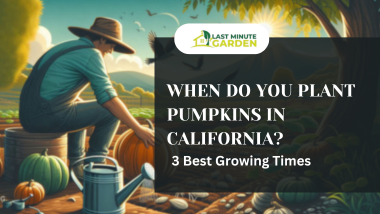When do you plant pumpkins in California? Did you know California’s warm days and cool nights make it one of the best places to grow vibrant, flavorful pumpkins just in time for Halloween?
Getting the right time to grow healthy and high-yield pumpkins in the varied climates of California is very significant.
Planting too early or late can affect growth, leading to smaller harvests or poor-quality pumpkins. With the appropriate timeframe, you can ensure a successful pumpkin production and get the quality for a season.
In this blog, we will deliberate on when do you plant pumpkins in California and the best planting times across California’s unique climates, helping in the selection of optimal seasons for planting pumpkins to ensure a healthy, abundant harvest. Let’s get on!
California’s Climate Zones for Pumpkin Growing
When do you plant pumpkins in California? Knowing California’s climate zones leads to successful growth at the right time.
California’s diverse climate zones—coastal, inland valleys, and desert regions—each present unique conditions that affect pumpkin planting timelines.
- Coastal areas generally have cooler temperatures and mild winters, making early spring or late summer ideal planting times.
- Inland valleys experience warm days and cooler nights, allowing for flexible spring and summer planting.
- Desert regions, with their intense heat, require careful timing to avoid extreme temperatures, often making late summer the best for planting.
These climate differences impact soil temperature, frost dates, and sunlight exposure, all critical for pumpkin growth, helping plants develop strong roots and mature fruit by harvest time. This answers, When do you plant pumpkins in California for Halloween?
The 3 Best Planting Times for Pumpkins in California
Best planting times give gardeners the flexibility to align with the states’ varied climates and ensure a healthy and abundant crop yield. These planting times include;
1. Early Spring Planting
As a gardener, when do you plant pumpkins in California? It is advisable to do early spring planting from late February to April. Depending on your specific climate zone and last frost date. Coastal and mild inland regions can often start in late February, while cooler inland valleys may benefit from waiting until mid-March or early April.
Ideal Conditions
Early spring planting works well in areas with mild spring temperatures and minimal risk of late frost, which could otherwise damage young plants.
Start early: This will allow pumpkins to benefit from gradually warming temperatures and a longer growing season, particularly in regions like coastal California where summer heat can be moderate.
Prepare the soil before planting: This process is key and helps to work on organic matter, such as compost or aged manure, to enhance nutrient content, drainage, and moisture retention.
Mound the soil slightly: This can also help warm it up faster, which is ideal for pumpkin seedlings that thrive in warm soil.
Gardeners in areas prone to early pests might also consider using floating row covers until plants are established, allowing them to avoid damage and promote steady early-season growth. This clears the worry about when do you plant pumpkins in California.
2. Late Spring/Early Summer Planting
Planting between April and June is classic for many regions of California. This period aligns well with California’s general growing season and offers the longest daylight and warm temperatures, which pumpkins love.
Planting in late spring to early summer is a preferred choice for timing pumpkins to mature by Halloween—a major appeal for home gardeners and pumpkin patch enthusiasts alike.
Planting during this window, pumpkins have enough warm days to establish, flower, and set fruit.
Additionally, it allows the plants to avoid late-season frost, ensuring they reach full maturity by October.
Tips: For gardeners who are seeking a head start, starting seeds indoors in April and transplanting them outdoors by May can speed up germination and provide young plants with a stronger foundation.
When transplanting, it’s crucial to harden off seedlings first by gradually exposing them to outdoor conditions. This reduces transplant shock and helps seedlings adjust to the climate.
A vigorous growth requires ensuring the soil is rich in organic matter and kept consistently moist, especially in warmer inland areas. This can be done by applying a thick layer of mulch to help retain soil moisture and keep root zones cool during hotter days, which are common in California summers.
3. Late Summer Planting
Late summer planting, typically from July to August, is a strategic choice for warmer inland and southern California regions where summer temperatures are often too intense for early growth. This later planting window allows pumpkins to take advantage of the lingering warmth of late summer while reaching maturity as fall temperatures cool.
Best For: Late summer planting is particularly suited for California’s inland valleys and southern regions, where pumpkins can still grow effectively as daytime temperatures begin to moderate and nights grow cooler.
Points: This timing helps protect young plants from the peak summer heat, which can cause stress and hinder early growth, and ensures they’ll mature in the more pumpkin-friendly temperatures of fall.
Pumpkins planted in this period are also less likely to encounter pests and diseases that peak during hotter months, such as powdery mildew and squash bugs.
Gardeners can boost success by choosing fast-maturing pumpkin varieties that will ripen by October or November.
In preparing for late summer planting, there should be enrichment of the soil with compost and ensure steady watering, as the soil may still be dry from the summer heat.
Regular, deep watering helps pumpkins develop strong roots to support large fruit, while shading seedlings temporarily can help them establish without scorching in the late-summer sun.
Tips for Successful Pumpkin Planting in California
Knowing when do you plant pumpkin in California and having successful pumpkin growth requires some essential processes. These are:
- Start with well-prepared soil that’s nutrient-rich and has good drainage; adding compost or aged manure can boost fertility.
- Irrigation is crucial in California’s dry summers—pumpkins need consistent, deep watering but not waterlogged soil.
- Adjust the frequency based on the local climate, focusing on keeping the soil evenly moist. Since pumpkins thrive in full sun, ensure they get at least 6–8 hours of sunlight daily.
- Proper spacing is essential; allow 4-6 feet between plants to accommodate sprawling vines, which helps reduce competition for light and nutrients and promotes healthy growth and larger yields.
Harvest Timing for California Pumpkins
The final harvesting time for California differs due to the planting seasons. For early spring plantings, harvesting is expected in September to early October; late spring plantings yield pumpkins in late October.
Signs of maturity include a hard rind, deep color, and dried vines. Harvest before the first frost for optimal flavor and storage longevity.
Common Challenges and Solutions in Pumpkin Growing
Every practice has its consequences or challenges, and planting pumpkins is not excluded.
These challenges in pumpkin cultivation include pests like aphids and diseases such as powdery mildew. To combat these, use organic solutions like neem oil and encourage beneficial insects.
During California’s drought, manage watering by applying mulch, using drip irrigation, and watering deeply but infrequently to promote strong root systems.
Final Thought
When do you plant pumpkins in California? To wrap everything up, the three best planting times for pumpkins in California are early spring (late February to April), late spring/early summer (April to June), and late summer (July to August). Each timing aligns with California’s unique climates for optimal growth.
New growers should experiment with these planting windows based on local conditions and remember to prepare nutrient-rich soil, manage to water wisely, and ensure ample sunlight for a successful pumpkin harvest.
Happy gardening!




